May 24, 2004 – I receive a lot of email from people who I've never met. Usually they have some sort of question or comment about Great Danes. Four days ago I received a note that, quite frankly, made me cringe.
This is what it said:
I confess I haven't replied to "xxxx"
because I don't think I could respond diplomatically. I'd like to find an experienced
breeder who possesses enough time and patience to attempt to dissuade Christina
from breeding this unfortunate puppy. Any takers? (Email me privately, please,
for contact information.)
This week we'll continue where we left
off, as Cindy talks about the birth and care of the litter:
Hallie's pregnancy progressed smoothly. As the delivery date approached, it was time
to decide whether to let her whelp naturally or schedule a cesarean. Naturally, you’d
think it’d be easier on the dam to let Mother Nature "do her thing" and
allow the pups to be born without the assistance of surgery. But if there’s
a large litter, or if you don’t want to take a chance on losing a puppy
during a difficult delivery, a c-section may be the best option. Many breeders
who are planning to do a natural whelp will request an x-ray the week prior to whelping.
This enables them to know exactly how many puppies are in utero. Obviously, it's
nice to know exactly how many pups you anticipate, so that you know when the birth process is completed.
We planned on a natural
delivery, and Hallie's pups were due on Monday, April 12th, exactly 60 days after the frozen
surgical implant. Well, so much for OUR plans. Hallie had other ideas...
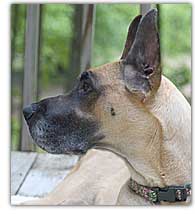 Past Due
Past Due
Monday came and went. Hallie's temp dropped to the 98.5 degrees at 11pm on Tuesday night – a signal that whelping
could occur anytime – but nothing happened. She slept and snored contentedly in her whelping box, while my dear friend (and
the best whelping assistant anyone could ask for) Arlene Perry and I panted, paced and
contracted. Wednesday afternoon we took Hallie in for evaluation. An x-ray
confirmed that all the pups were alive and in proper position. We were sent home. That
night we administered two Oxytocin shots to stimulate labor and we were rewarded with not so
much as a single contraction. By Thursday morning, I was no good. Never mind Hallie.
For my own mental health, I needed that c-section. So off we went, back to the clinic.
Dogs Can't Read
My veterinarian had tried to convince me throughout this ordeal that dogs don't read the manual on canine reproduction, so Hallie wasn't aware of "the 60-day
rule." He looked her over, found her body temp was where it should be and saw no discharge of any kind. Her x-ray was normal and she was was snoring happily, which was probably the most convincing
evidence of normalcy. The pups are fine, he reassured me. However, I must confess that
I did NOT share his confidence. It could be uterine inertia. And yet, Hallie
may whelp naturally given a few more hours. What to do?
My contorted expression, combined with uncontrollable facial twitching, was
all the direction my vet needed. We followed him back to the surgical suite
and began assisting with the prep, along with seven vet techs – and I'm
NOT kidding about that number. (I have witnesses!) As it turned out, my vet had been right. He
delivered three big, active, healthy, not-overcooked babies. They started screaming,
and I started bawling. There wasn't an employee in that hospital that didn't
stop what they were doing to come back to hug and congratulate us.
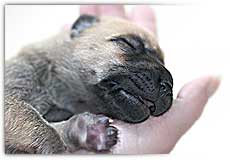 Caring for Newborn
Puppies
Caring for Newborn
Puppies
Once a litter is born, the puppies must be kept warm – at 75 to 80 degrees – at
least for the first week. We keep ours in a solidly constructed 6x6 foot whelping box. This allows plenty of room for the dam and her
pups, plus the breeder and her assistant, both of whom will be living in the box for the next two weeks keeping careful watch to ensure that
none of the babies are squished by Mom. Bathroom breaks, showers and any other necessary trips away from the box require the
pups to be loaded into a basket for safe keeping until your return.
Dew claws are usually removed on day three. I try to schedule the first appointment of the day because the clinic is cleaner and not yet contaminated by possible
viruses and other demons. The dam should be brought along but left in the car to minimize her stress. Pups should be covered in a basket with a hot water bottle
to keep their body temperatures warm.
Ten to fourteen days after delivery, the Mom has her stitches
removed if she has had a c-section. You'll be steam cleaning the carpets unless you've laid down plastic, because your dam will be leaking a discharge
for up to 6 weeks post-delivery.
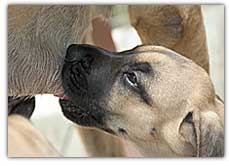 Until
they're around four weeks old, a dam with good mothering instincts will clean her puppy's bottoms, which stimulates elimination. She licks up any and all accidents, which leaves you to only worry about changing and washing bedding in the whelping box. After
they're four weeks of age, Mom decides she's had enough of that job, and merrily passes it on to you. This particular job will keep you hopping. While it's certainly
one of my least favorite tasks, it is essential to maintain good hygiene
in order to fend off parasitic illnesses such as Giardia and Coccydia.
Until
they're around four weeks old, a dam with good mothering instincts will clean her puppy's bottoms, which stimulates elimination. She licks up any and all accidents, which leaves you to only worry about changing and washing bedding in the whelping box. After
they're four weeks of age, Mom decides she's had enough of that job, and merrily passes it on to you. This particular job will keep you hopping. While it's certainly
one of my least favorite tasks, it is essential to maintain good hygiene
in order to fend off parasitic illnesses such as Giardia and Coccydia.
I weigh my puppies on
a daily basis up until about age two weeks, then weekly thereafter, to assure
they're gaining adequately. Careful notes are kept about each pup for later reference. At the age of three weeks the pups are introduced
to solid food. A mixture of Mom's dog food, canned puppy formula, and warm water is soaked and blended in the food processor.
Yum. Lots of newspapers are under the pups as you feed them their first solid food off the end of your finger, most of which ends up all over you and the babies!
It's messy business and better done outside, weather permitting. Gradually the pups are weaned away from Mom's milk until by age six weeks they eat only solid
food soaked in warm water. Any vitamins and supplements are crushed and added to the mix.
 At age five weeks,
the pups get their first shots; then again at age seven weeks, prior to the upcoming
ear-cropping, which must be done within a certain period of time. Most crops are done around
7-8 weeks old. THIS IS LOTS OF FUN, and it could help you decide NEVER to breed again!
At age five weeks,
the pups get their first shots; then again at age seven weeks, prior to the upcoming
ear-cropping, which must be done within a certain period of time. Most crops are done around
7-8 weeks old. THIS IS LOTS OF FUN, and it could help you decide NEVER to breed again!
Ear croppings
must be done by a veterinarian with many years of experience cropping Dane pups.
NEVER allow a novice to do your cropping.
Aftercare for the
cropped ears is tedious and requires assistance, coaching and mentoring from
a seasoned Dane breeder to assure they heal properly and without infections.
Four days to a week after cropping, the stitches are taken out and the
ears are posted up. This requires guidance from a veteran ear-taper.
Those breeders who
elect to crop ears take the entire process VERY seriously. After all, a botched
ear cropping will ruin the look of a beautiful dog, not to mention the possibility
of losing an ear or, worse yet, losing the pup from a
nasty infection.
Why Do We
Breed?
It's hard for many people to understand why well-bred puppies of any breed cost as much as they do, but then again, most people don't
have a CLUE as to the amount of hard work, the intense worry, the exhausted tears, and the incredible expense that goes into raising a litter
of well-bred puppies.
When all is said and done, if there is any financial profit, it is minimal. Do you want to know
why we do it – why we put ourselves and our families and our dams through
five months of total upheaval just to produce and raise a litter?
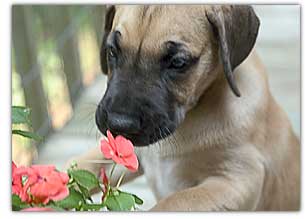 It's
because of the overwhelming sense of pride we feel when we watch our puppies go around that show ring, or earn an obedience title, or play with small children
with the greatest of care, or plant their front feet on the shoulders of their owner and lick their entire face.
It's
because of the overwhelming sense of pride we feel when we watch our puppies go around that show ring, or earn an obedience title, or play with small children
with the greatest of care, or plant their front feet on the shoulders of their owner and lick their entire face.
It's because, as we watch them grow into adults, we know what it took to get them to what and
where they are today. It's because of us that these magnificent creatures exist.
We made the decision to create them and we labored intensely, made tough decisions,
in order to bring them through their first few moments, days, and weeks of life.
Finally, it's because they never forget you. Years down the road, when they hear your voice
from a distance their eyes will light up, their tails will start wagging, and they'll have recognized you!
You'll always be special to them because no one knows better than they do just how much
love you gave them, and the many lessons you taught them.
That's why we do it.

![]()



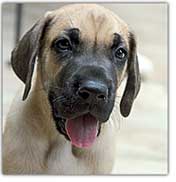 Back
to the Story
Back
to the Story
 Caring for Newborn
Puppies
Caring for Newborn
Puppies Until
they're around four weeks old, a dam with good mothering instincts will clean her puppy's bottoms, which stimulates elimination. She licks up any and all accidents, which leaves you to only worry about changing and washing bedding in the whelping box. After
they're four weeks of age, Mom decides she's had enough of that job, and merrily passes it on to you. This particular job will keep you hopping. While it's certainly
one of my least favorite tasks, it is essential to maintain good hygiene
in order to fend off parasitic illnesses such as Giardia and Coccydia.
Until
they're around four weeks old, a dam with good mothering instincts will clean her puppy's bottoms, which stimulates elimination. She licks up any and all accidents, which leaves you to only worry about changing and washing bedding in the whelping box. After
they're four weeks of age, Mom decides she's had enough of that job, and merrily passes it on to you. This particular job will keep you hopping. While it's certainly
one of my least favorite tasks, it is essential to maintain good hygiene
in order to fend off parasitic illnesses such as Giardia and Coccydia.  At age five weeks,
the pups get their first shots; then again at age seven weeks, prior to the upcoming
ear-cropping, which must be done within a certain period of time. Most crops are done around
7-8 weeks old. THIS IS LOTS OF FUN, and it could help you decide NEVER to breed again!
At age five weeks,
the pups get their first shots; then again at age seven weeks, prior to the upcoming
ear-cropping, which must be done within a certain period of time. Most crops are done around
7-8 weeks old. THIS IS LOTS OF FUN, and it could help you decide NEVER to breed again! It's
because of the overwhelming sense of pride we feel when we watch our puppies go around that show ring, or earn an obedience title, or play with small children
with the greatest of care, or plant their front feet on the shoulders of their owner and lick their entire face.
It's
because of the overwhelming sense of pride we feel when we watch our puppies go around that show ring, or earn an obedience title, or play with small children
with the greatest of care, or plant their front feet on the shoulders of their owner and lick their entire face.